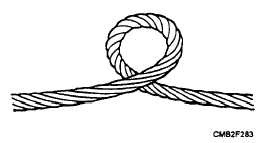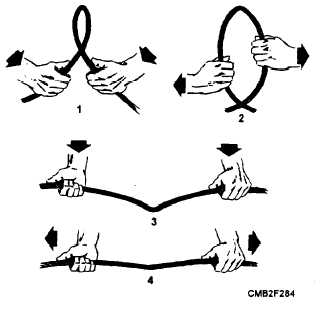A good method for unreeling wire rope is to run a pipe or rod through the center and mount the reel on drum jacks or other supports so the reel is off the ground, as shown in figure 6-40. In this way, the reel will turn as the rope is unwound, and the rotation of the reel helps keep the rope straight. During unreeling, pull the rope straightforward, and avoid hurrying the operation. As a safeguard against kinking, NEVER unreel wire rope from a reel that is stationary.
To uncoil a small coil of wire rope, simply stand the coil on edge and roll it along the ground like a wheel, or hoop, as also shown in figure 6-40. NEVER lay the coil flat on the floor or ground and uncoil it by pulling on the end, because such practice can kink or twist the rope.
KINKS. - One of the most common forms of damage resulting from improper handled wire rope is the development of a kink. A kink starts with the formation of a loop, as shown in figures 6-41 and 6-42.
A loop that has not been pulled tight enough to set the wires or strands or the rope into a kink can be removed by turning the rope at either end in the proper direction to restore the lay (fig. 6-43). If this is not done and the loop is pulled tight enough to cause a kink (fig. 6-44), the kink will result in irreparable damage to the rope (fig. 6-45).

Figure 6-40. - Unreeling wire rope (left); uncoiling wire rope (right).

Figure 6-41. - Improper handling.

Figure 6-42. - Wire rope loop.

Figure 6-43. - The correct way to take out a loop in a wire rope.

Figure 6-44. - Wire rope kink.

Figure 6-45. - Kink damage.
Kinking can be prevented by proper uncoiling and unreeling methods and by the correct handling of the rope throughout its installation.
DRUM WINDING. - Spooling wire rope on a crane hoist drum causes a slight rotating tendency of the rope due to the spiral lay of the strands. Two types
Continue Reading